Send Us a Message
Contact Information
Skizzle Technolabs India Pvt. Ltd.
Noel Focus, Kakkanad,
Kerala, India – 682021
Beyond manufacturing, digital twin technology has merged the realms of the Internet of Things, artificial intelligence, and data analytics.
Data scientists and other IT experts will be able to optimize deployments for peak performance and develop other what-if scenarios as more complicated “things” become connected with the ability to provide data.

The Internet of Things (IoT) and digital twins are transforming how digital and physical worlds interact. IoT connects and gives people access to intelligence in the physical world, and it’s related to digital twins, which are digital replicas of their physical counterparts.
In order to understand the full potential of digital twins of physical products, operational processes, or people’s tasks in 2021, IoT must be a significant strategic concern. A real digital twin must record the physical world experiences of these three Ps: products, processes, and people via sensors and IoT.
The digital twin market is forecasted to be $16 billion and IDC predicts that 30 percent of Global 2000 organizations will use data from digital twins of IoT connected devices and assets by 2023, and analysts agree that IoT will be a key driver of this growth.
A digital twin is a computer model of a physical object or system. Digital twin technology has expanded to cover huge items such as buildings, industries, and even cities, and some have suggested that individuals and processes can have digital twins, further broadening the concept. The idea first arose at NASA: full-scale models of early space capsules, which were used on the ground to reflect and diagnose issues in orbit, gave way to totally computerized simulations.
However, the term gained traction after Gartner designated digital twins as one of the top 10 strategic technology trends for 2017, predicting that “billions of things would be represented by digital twins, a dynamic software model of a physical thing or system, within three to five years.” “A year later, Gartner recognized digital twins as a top trend, predicting that “by 2020, digital twins will exist for billions of things,” citing an estimate of 21 billion linked sensors and endpoints in the near future.”
In essence, a digital twin is a computer program that accepts real-world data about a physical thing or system as inputs and delivers predictions or simulations of how those inputs will impact that physical object or system as outputs.
A digital twin begins its life being built by specialists, often experts in data science or applied mathematics. These developers research the physics that underlie the physical object or system being mimicked and use that data to develop a mathematical model that simulates the real-world original in digital space.
The twin is constructed so that it can receive input from sensors gathering data from a real-world counterpart. This allows the twin to simulate the physical object in real-time, in the process offering insights into performance and potential problems. The twin could also be designed based on a prototype of its physical counterpart; in which case, the twin can provide feedback as the product is refined; a twin could even serve as a prototype itself before any physical version is built.
A digital twin can be as complicated or as simple as you like, and the amount of data you use to build and update it will determine how precisely you’re simulating a physical object.
Clearly, the explosion of IoT sensors is part of what makes digital twins possible. And as IoT devices are refined, digital-twin scenarios can include smaller and less complex objects, giving additional benefits to companies.
Digital twins can be used to predict different outcomes based on variable data. This is similar to the run-the-simulation scenario often seen in science-fiction films, where a possible scenario is proven within the digital environment. With additional software and data analytics, digital twins can often optimize an IoT deployment for maximum efficiency, as well as help designers, figure out where things should go or how they operate before they are physically deployed.
The more that a digital twin can duplicate the physical object, the more likely it that efficiencies and other benefits can be found. For instance, in manufacturing, where the more highly instrumented devices are, the more accurately digital twins might simulate how the devices have performed over time, which could help in predicting future performance and possible failure.
From augmenting the ability to run diverse experiments to giving real-time insights, a digital twin helps IoT in a number of ways. Some of them are detailed below:
What will happen if the workflow is tweaked? Will it get more data, will it result in consuming less energy, will it result in a better user experience? These are some insights that a digital twin can give in an IoT environment. All this without having to push updates for the physical device working in a production environment.
Experiments of any kind are difficult. They incur expensive resources, and if they do not work out as planned can even cost more than planned. IoT is a relatively new technology, and there is an abundant need for experimentation. The experimentation needs to be carried out with judicious usage of resources. Digital twins provide the virtual infrastructure to conduct countless experiments even when there are not many physical devices available.
IoT’s most popular benefit is that it gives access to a large number of devices at the same time. This, in turn, is also a downside. A minor security flow can give room for hackers and unauthorized personnel to gain access to the IoT network. The risk is magnified when actual physical devices deployed in production are used for experimentation.
Digital twins take away that risk. It makes it possible for developers and researchers to safely toy with multiple scenarios before arriving at a final one that is secure and operationally feasible.
Smart connected products are replacing assumptions with facts; real-world IoT data closes the feedback loop with product usage data, which then informs future iterations – and even business model changes, including product-as-service. Product telemetry also gives engineers and product designers behavioral characteristics of deployed products or fleets of products.
Providing a frame of reference to compare the ‘as-is’ versus ‘as used’ product usage is an extremely powerful IoT-enabled insight that can inform the development of future product iterations. Its applicability can range from replacing or modifying certain features to drilled-down insights into the specific performance of part(s).
Expanding visibility into the product lens through cross-functional collaboration can also drive downstream efficiencies. This includes change management in manufacturing and service processes, which lowers scrap, rework, and lead times.
For Example, Whirlpool is achieving data-driven design by connecting deployed appliances through IoT and analyzing operating performance metrics (torque, drum speed, motor temperature, etc.) across fleets of products to improve future iterations.
Many operational processes are plagued by two factors: disparate and black-boxed information sources. IoT unlocks these unknown insights and threads them with different sources both in real-time and historical systems of record. Twins of these connected assets and workers and how they interact are critical to constructing a process lens – essentially a system-wide view of an industrial environment.
IoT through a process lens can drive critical manufacturing KPIs. For example, improving the uptime of a single asset on a factory floor through IoT-driven predictive insights can drastically improve throughput while a twin of a production line can reduce bottlenecks through enhanced operational visibility.
This connected operational intelligence from diverse assets creates the real-time 360-degree visibility manufacturers need to be flexible and agile – a necessity in today’s changing markets and shifting customer demands.
For Example, Woodward is gaining operational visibility by integrating its technologies and workers through the IoT across its factories. An IoT platform contextualizes myriad information sources in its production facilities, including connected devices (torque wrenches, pressers, etc.), manufacturing execution systems (MES), and product centric-software (CAD, PLM), to give an end-to-end operational view.
Much of a product’s operational condition and performance in the end user’s environment hasn’t been accessible to the manufacturer or customer. With maintenance and service being critical functions to reduce asset downtime and differentiate offerings, digital twins with IoT can drastically improve these metrics and enable new revenue streams.
Digital twins can bolster remote service IoT use cases where software updates, patches or reboots for deployed assets can negate the need to send a technician on-site. IoT’s flexibility can enable mission-critical systems to sample data every second to inform services, or less frequently to optimize resources, all depending on the digital twin use case.
Telemetry data can also feed into the deployed asset’s digital twin to gain a baseline of its health and apply next-generation predictive maintenance modules blending machine learning and physics-based simulation techniques. Simulating historical patterns of machine performance with design expectations against real-time sensor data will reduce unplanned downtime and add another layer of intelligence, which further maximizes asset utilization.
For Example, Howden is helping customers succeed through its ‘Data-Driven Advantage’ program. This initiative has embedded IoT-driven insights into customers’ service and maintenance workflows to save millions in unplanned downtime and reduce business risk.
Building a digital twin is complex, and there is as yet no standardized platform for doing so. Ian Skerrett, a consultant working in the field who has a long history in open source behind him, has proposed the outline of a digital twin platform, though this is the first step, as suits the rather embryonic nature of the space.
In contrast with many emerging technologies, commercial digital-twin offerings are actually coming from some of the largest companies in the field. For instance, GE, which developed digital-twin technology internally as part of its jet-engine manufacturing process, is now offering its expertise to customers, as is Siemens, another industrial giant heavily involved in manufacturing. Not to be outdone by these factory-floor suppliers, IBM is marketing digital twins as part of its IoT push, and Microsoft is offering its own digital-twin platform under the Azure umbrella.
The digital twin “can include a description of the devices, a 3D rendering, and details on all the sensors in the device. It continuously generates sensor readings that simulate real-life options.”
As per NetworkWorld. the predictive twin “models the future state and behavior of the device,”. “This is based on historical data from other devices, which can simulate breakdowns and other situations that need attention.”
As part of its digital-twin initiative, Microsoft is taking the concept and applying it to processes in addition to physical products. In a whitepaper, Microsoft proposes the idea of the digital process twin:
“The Process Digital Twin is the next level of digital transformation, compounding Product Digital Twin benefits throughout the factory and supply chain,” Microsoft states. The associated whitepaper highlights some advanced manufacturing scenarios that product digital twins don’t support, but that process digital twins would.
Digital twins offer a real-time look at what’s happening with physical assets, which can radically alleviate maintenance burdens. Chevron is rolling out digital twin tech for its oil fields and refineries and expects to save millions of dollars in maintenance costs. And Siemens as part of its pitch says that using digital twins to model and prototype objects that have not been manufactured yet can reduce product defects and shorten time to market.
But keep in mind that Gartner warns that digital twins aren’t always called for, and can unnecessarily increase complexity. “[Digital twins] could be technology overkill for a particular business problem. There are also concerns about cost, security, privacy, and integration.”
The rise of digital twins coincides with the rise of the IoT. Gartner predicts that there will be billions of things represented by digital twins within the next five years. As the tech world is on the cusp of a digital twin technology explosion, enterprises that are not already utilizing digital twins should plan to investigate their potential to gain a competitive advantage.

High-performing teams are the distinctive feature of an industry-leading business. This can ensure the business's success in the long run. Working in a team...
Read More
Since the pandemic hit the world, the new normal is working from home. Gen Y and Gen Z are the largest workforce units of...
Read More
You have much to consider when looking for a solution for human resources (HR) technology. What is the right fit for you? How are...
Read More
As we have seen human resources and information technology have become more intertwined during the last decade. Manufacturing, financials, sales and marketing, and supply...
Read MoreSkizzle Technolabs India Pvt. Ltd.
Noel Focus, Kakkanad,
Kerala, India – 682021